By Travis Allen
As we approach Theros spoilers (Wizard’s PAX party is this coming weekend, where last year we saw the return of the shocks and Dreadbore, among others), it’s a good time to pay attention to what is on the way out. Rotation will not only be the starter pistol for Ravnica rares to take off on price surges, but is also a chance to grab up Innistrad cards for what may be the lowest they will be in years. I’m going to browse all of Innistrad block and M13 for anything that jumps out at me.

Army of the Damned – This is a casual card that is absolutely dripping with flavor. It’s highly unlikely to do much in any real format, but ongoing casual and EDH demand may cause a rise here down the road. I don’t see it spiking in two months, but this may pull a Sanguine Bond and quietly end up at $7 or $8.
Avacyn, Angel of Hope – Knight Exemplar is a $3 card despite having been printed three times and seeing zero competitive play. Indestructible is a casual fan favorite. That same demographic of players also love Angels. That is why Avacyn is currently nearly $15. She will be over $20 within probably a few months, and should live between $20 and $30 for years. This isn’t exactly a spec target, but if you wanted any, now would be the time to acquire. Foils are nearly $50, and will only stand to gain as well.
Bonfire of the Damned – I don’t like Bonfire long term. It’s seen virtually no play elsewhere, and isn’t particularly cool. I’m not sure the card will ever be worth more than it is right now.
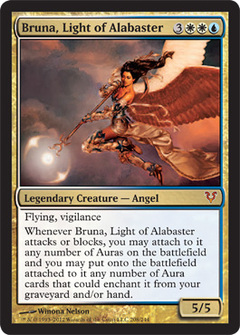 Bruna, Light of Alabaster – While having done nothing in Standard, it’s still an angel that plays well with Auras. This card is barely $1, and it would basically be impossible to lose money on her. Not many angels are less than $1. She also has the marginal chance of showing up in Modern if any auras make her particularly vicious. Exalted with Sovereigns of Alara used to be a thing, and Eldrazi Conscription still exists.
Bruna, Light of Alabaster – While having done nothing in Standard, it’s still an angel that plays well with Auras. This card is barely $1, and it would basically be impossible to lose money on her. Not many angels are less than $1. She also has the marginal chance of showing up in Modern if any auras make her particularly vicious. Exalted with Sovereigns of Alara used to be a thing, and Eldrazi Conscription still exists.
 Descendants’ Path – While nothing ever came of this in Standard, it has a non-zero chance to break into Modern at some point. Casting free spells is awesome, especially if they have “Eldrazi” written on them somewhere. Imagine when they return if we get a Llanowar Elf that is colorless, taps for colorless, and is an Eldrazi?
Descendants’ Path – While nothing ever came of this in Standard, it has a non-zero chance to break into Modern at some point. Casting free spells is awesome, especially if they have “Eldrazi” written on them somewhere. Imagine when they return if we get a Llanowar Elf that is colorless, taps for colorless, and is an Eldrazi?
Even if it isn’t an eldritch horror that breaks it, it’s not hard to imagine humans or, hell, even Minotaurs doing it. At 50 cents, Descendants’ Path seems very safe, even if it may not pop for a while.
Garruk Relentless – Few Planeswalkers are worth less than $6, which is right around where Garruk is today. Garruk is also the only transforming Planeswalker that exists and will likely stay that way for years. Additionally, he’s a strong card that even shows up in Modern from time to time. I expect foils of this guy to be particularly fertile ground, as I’ve seen a lot of people collecting foil flip cards for the sole reason that they’re foil flip cards.
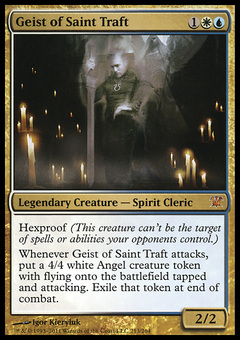 Geist of St. Traft – The ghost is a massive force in Modern and Legacy. I can’t see this card’s floor being any less than $15, if it even gets that low. Get in now if you need them, and if they fall two or three dollars, be happy with that rather than having not bought them and seeing them jump by $15.
Geist of St. Traft – The ghost is a massive force in Modern and Legacy. I can’t see this card’s floor being any less than $15, if it even gets that low. Get in now if you need them, and if they fall two or three dollars, be happy with that rather than having not bought them and seeing them jump by $15.
Gisela, Blade of Goldnight – This card is $5 and has not seen a lick of play in Standard. Like Bruna, being an angel is enough to be worth money, and will assuredly tick up in price steadily for a while after falling out of Standard.
Griselbrand – $10 and the reanimator/breacher of choice in every format that type of degeneracy is permitted. Like many others on this list, he is at his floor until he gets Griselbanned.
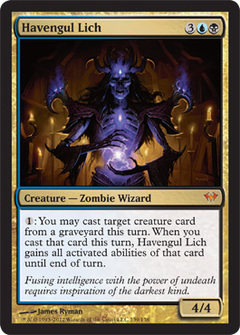 Havengul Lich – I got in on this guy way back when and he’s done nothing but take up space since, but I’m still a firm believer. Havengul Lich has a powerful, unique ability that would be the engine of a combo deck. He’s a popular creature type, he’s in great combo colors, and he’s a mythic from a middle set that was fairly unpopular. I don’t see how this guy ISN’T over $10 at some point in the future. How far that future is, though, I am unsure of.
Havengul Lich – I got in on this guy way back when and he’s done nothing but take up space since, but I’m still a firm believer. Havengul Lich has a powerful, unique ability that would be the engine of a combo deck. He’s a popular creature type, he’s in great combo colors, and he’s a mythic from a middle set that was fairly unpopular. I don’t see how this guy ISN’T over $10 at some point in the future. How far that future is, though, I am unsure of.
Innistrad lands – I’m mentioning these to tell you that they are not pickups. They are completely irrelevant in every format except for Standard, and you won’t need them until they’re legal there again. If you can get a good price for yours now I’d ditch them. Other than that, stick the 40 in a plastic sleeve somewhere to dig out again in 4 years.
Huntmaster of the Fells – This is another card that has so far been very relevant in Standard, but I dislike long term. He sees a little bit of play in Modern Jund, but I don’t believe that this is the four drop Jund wants. Sure, he does some things, but I can’t imagine this is the highest impact 4-drop Jund could be running. I may be proven wrong here, but I’m ok with the chance of that.
Liliana of the Veil – I’m reasonably confident this card isn’t going much lower. Liliana has seen play in Standard, but she has seen far more action in Modern and Legacy (T1 dark ritual lol) in the last two years, and typically as a 4-of. Jace has shown us what the ceiling looks like for Planeswalkers, and it’s a lot higher than $40. I’m not saying she’ll hit $150, but I could see her cresting $60 or $70 without a reprint. I’m putting my money where my mouth is on this one; I have a few spare that I pulled off my sale list because I believe she has room to grow.

Mikaeus, the Unhallowed – When was the last time you saw a black EDH deck that didn’t run Mikaeus? He’s also an immediate win off of Tooth and Nail with Triskelion, if that ever becomes a Thing. He’s not necessarily a spec target, but a “if you need any grab them.”
 Omniscience – I’m a big fan of this card, and not just because I’ve had tournament success with it. It’s a huge splashy card that casual players are drawn to, and it’s obscenely powerful to cheat into play. Resolving this is frequently going to be a win in Modern and Legacy, and being a critical combo piece, will likely be a 4-of. We’ve got a core set Mythic that has eternal demand, casual demand, and EDH demand. Looks like a winner to me.
Omniscience – I’m a big fan of this card, and not just because I’ve had tournament success with it. It’s a huge splashy card that casual players are drawn to, and it’s obscenely powerful to cheat into play. Resolving this is frequently going to be a win in Modern and Legacy, and being a critical combo piece, will likely be a 4-of. We’ve got a core set Mythic that has eternal demand, casual demand, and EDH demand. Looks like a winner to me.
Past in Flames – Its $1. If you don’t have 4, grab 4.
Primal Surge – At under $1, this is another one that seems safe. You can sock this away in a box with your Havengul Liches and not feel bad having spent $10 on a bunch. Either casual play drives it up to a few bucks each in a year, or some funky Modern combo appears that involves you dumping your entire deck into play using this card. Either way, it’s low risk and low opportunity cost.
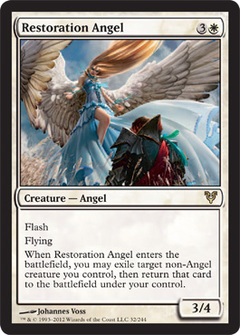 Restoration Angel – I did a double take when I saw this was down to $5. Wasn’t this card like 20 bucks recently? While not particularly relevant in Legacy, she’s good beats in Modern, and again, an angel. Not only is she also a natural combo piece for Kiki-Jiki, but the right 3-drop with a fantastic ETB could really do work with her.
Restoration Angel – I did a double take when I saw this was down to $5. Wasn’t this card like 20 bucks recently? While not particularly relevant in Legacy, she’s good beats in Modern, and again, an angel. Not only is she also a natural combo piece for Kiki-Jiki, but the right 3-drop with a fantastic ETB could really do work with her.
Sigarda, Host of Herons – See Bruna and Gisela.
Snapcaster Mage – Believe it or not, I’m not too bullish on this guy. $20 is a hefty tag for a rare in one of the most opened sets in Magic history. He’ll be leaving Standard and has seen very little action in Legacy. He’s obviously good for sure, and has seen a lot of play in Modern, but when that’s the only format he’s really doing work in, how much can he be worth? I wouldn’t sell your set, but I’m not sure I’d be in a rush to snap (heh) him up either. If he dips and then starts to rise again, it will be a slow rise, so you won’t miss a good buy-in window.
Temporal Mastery – This card does say Time Walk, right? Temporal Mastery sees some amount of play in Legacy, but has yet to break into Modern. I don’t think the support for this exists there yet, but I believe it will at some point, and when it does, this will be a 4-of. I wouldn’t call it a spec target, because it could take quite some time to get there, but if you’ve already got them, I don’t think I’d be looking to get rid of them.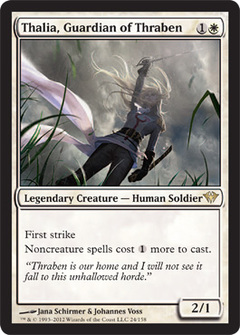
Thalia, Guardian of Thraben – Thalia is doing a ton of work in Modern and Legacy right now as an absolute nightmare for control/combo decks that doubles as a reasonable threat. $3 for her seems pretty low to me. $7-$8 feels a lot more appropriate. It may not happen overnight, but I like her a lot over the next year.
Cards of the week:
- I talked about Chandra, Pyromaster a few weeks ago when she was a cool $10. She’s jumped a few bucks since then, and has been consistently showing up in Top 8s. I wouldn’t be surprised to see hear near $20 in the next three months.
- Glimpse the Unthinkable is getting chatted up a lot around Twitter/articles lately. The card slowly climbed from $12 to $20 over the last few years purely on casual demand. It wasn’t printed in Modern Masters or the Ravnica block, which were the two most likely places to see Glimpse again. This feels like it may be another Horizon Canopy, or close to it.
- It took a few extra weeks, but Kor Spiritdancer jumped from $2.50 to $7.50. Keen Sense saw a jump as well, although less pronounced.









 Devout Invocation
Devout Invocation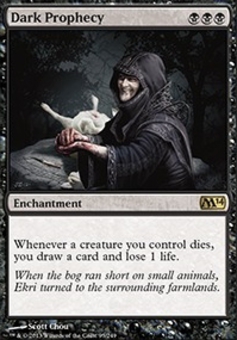 Dark Prophecy
Dark Prophecy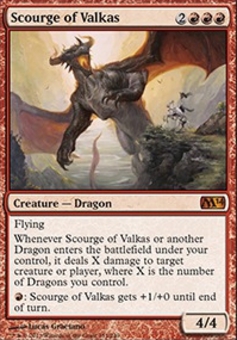 Scourge of Valkas
Scourge of Valkas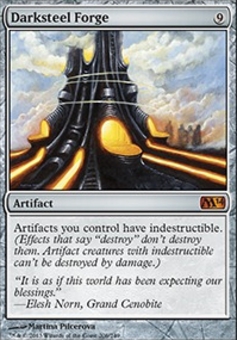 Darksteel Forge
Darksteel Forge